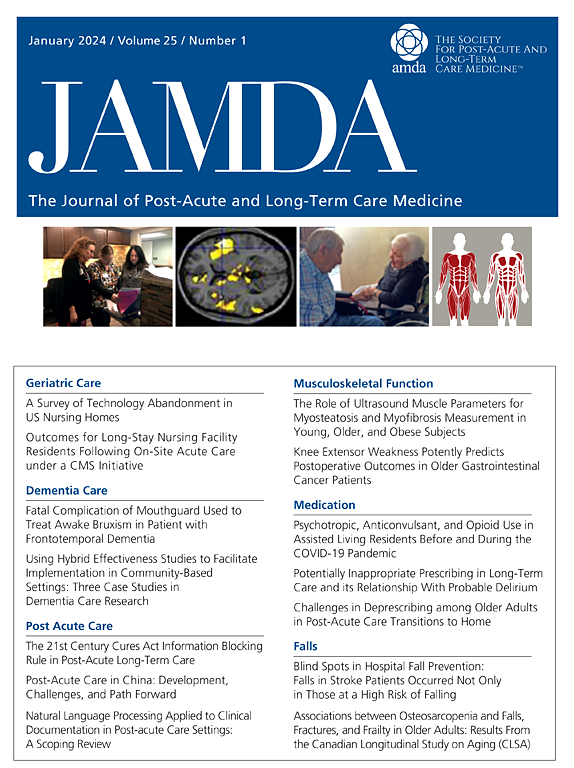新西兰奥特亚罗瓦社区痴呆症患者尿失禁的发生率、患病率和风险:一项 interRAI 研究。
IF 4.2
2区 医学
Q2 GERIATRICS & GERONTOLOGY
Journal of the American Medical Directors Association
Pub Date : 2024-09-23
DOI:10.1016/j.jamda.2024.105285
引用次数: 0
摘要
目的确定痴呆症患者的 1 年患病率、5 年发病率和尿失禁(UI)风险:设计:回顾性队列研究:参与者在 2016 年 8 月 1 日至 2021 年 7 月 31 日的 5 年间在新西兰奥特亚罗瓦完成了国际居住评估工具家庭护理(interRAI-HC)评估(N = 109,964):为了进行患病率分析,我们选取了 2020 年 8 月 1 日至 2021 年 7 月 31 日这 1 年期间的痴呆症队列(n = 7775)。在发病率分析中,对痴呆症队列中的参与者从首次诊断痴呆症开始进行为期 5 年的随访。痴呆症通过合并 "阿尔茨海默病 "和 "阿尔茨海默病以外的痴呆症 "诊断来确定。如果参与者很少、偶尔或经常大小便失禁,或使用导尿管/造口术控制大小便失禁,则将其编码为 UI。单变量和多变量逻辑回归分析确定了预测尿失禁发病的风险因素。Cox 回归分析比较了痴呆组和非痴呆组的生存曲线(无尿失禁的月数),并调整了任何一组中与尿失禁事件显著相关的变量:痴呆症患者在 1 年内(2020 年 8 月 1 日至 2021 年 7 月 31 日)的尿失禁发生率为 50.1%。痴呆症队列的 5 年尿失禁发生率为每 100 人年 30.2 例,非痴呆症队列为每 100 人年 24.5 例。在两个队列中,帕金森病造成的尿失禁风险最大(痴呆队列奇数比 [OR],3.0;95% CI,2.1-4.2;非痴呆队列 OR,1.7;95% CI,1.4-2.0)。在控制风险因素后,痴呆症患者的尿失禁危险比为1.4:在新西兰奥特亚罗瓦,有相当一部分痴呆症患者受到尿崩症的影响。医疗专业人员应直接询问尿失禁情况,并考虑痴呆症患者的生活安排和合并症。从interRAI-HC中获得的数据驱动的见解可以指导资源分配和服务规划。本文章由计算机程序翻译,如有差异,请以英文原文为准。
Incidence, Prevalence, and Risk for Urinary Incontinence for People with Dementia in the Community in Aotearoa New Zealand: An interRAI Study
Objectives
To identify 1-year period prevalence, 5-year incidence rate, and risks for urinary incontinence (UI) for people living with dementia.
Design
Retrospective cohort study.
Setting and Participants
Participants completed an International Residential Assessment Instrument Home Care (interRAI-HC) assessment in a 5-year period between August 1, 2016 and July 31, 2021 in Aotearoa New Zealand (N = 109,964).
Methods
For prevalence analysis, a dementia cohort was selected for a 1-year period from August 1, 2020 to July 31, 2021 (n = 7775). For incidence analysis, participants in the dementia cohort were followed from the first dementia diagnosis during the 5-year period. Dementia was identified by combining diagnoses of “Alzheimer's disease” and “Dementia other than Alzheimer's disease.” Participants were coded with UI if they were infrequently, occasionally, or frequently incontinent or if continence was managed with catheter/ostomy. Univariate and multivariate logistic regression analyses identified risk factors predicting UI onset. Cox regression analysis compared survival curves (months without UI) of the dementia and non-dementia cohorts, adjusting for variables significantly associated with incident UI in either cohort.
Results
The 1-year period (August 1, 2020 to July 31, 2021) prevalence of UI was 50.1% among people with dementia. The 5-year incident UI rate was 30.2 per 100 person-years for the dementia cohort and 24.5 per 100 person-years for the non-dementia cohort. Parkinson's disease posed the greatest risk of UI in both cohorts [dementia cohort odds ratio (OR), 3.0; 95% CI, 2.1–4.2; non-dementia cohort OR, 1.7; 95% CI, 1.4–2.0]. Controlling for risk factors, the hazard ratio for UI was 1.4 for people with dementia.
Conclusions and Implications
UI affects a significant proportion of people with dementia in Aotearoa New Zealand. Health professionals should directly ask about UI and consider living arrangements and comorbidities for people with dementia. Data-driven insights from interRAI-HC can guide resource allocation and service planning.
求助全文
通过发布文献求助,成功后即可免费获取论文全文。
去求助
来源期刊
CiteScore
11.10
自引率
6.60%
发文量
472
审稿时长
44 days
期刊介绍:
JAMDA, the official journal of AMDA - The Society for Post-Acute and Long-Term Care Medicine, is a leading peer-reviewed publication that offers practical information and research geared towards healthcare professionals in the post-acute and long-term care fields. It is also a valuable resource for policy-makers, organizational leaders, educators, and advocates.
The journal provides essential information for various healthcare professionals such as medical directors, attending physicians, nurses, consultant pharmacists, geriatric psychiatrists, nurse practitioners, physician assistants, physical and occupational therapists, social workers, and others involved in providing, overseeing, and promoting quality

 求助内容:
求助内容: 应助结果提醒方式:
应助结果提醒方式:


